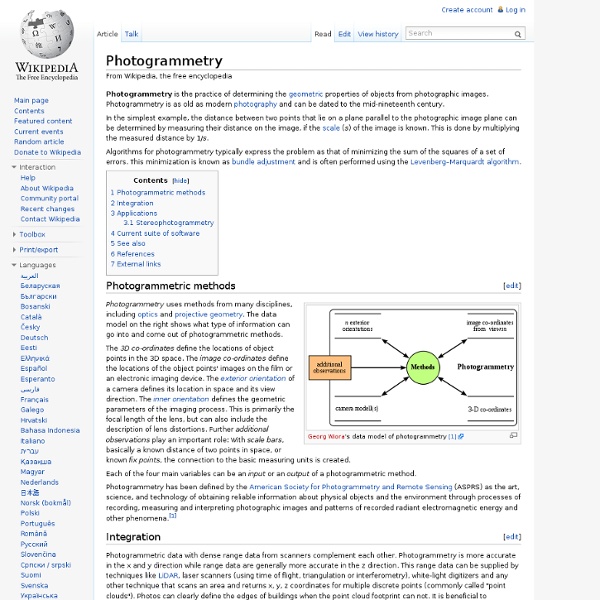Photogrammetry

RawTherapee Blog
luca-penasa/Apero2Meshlab
Overcoming My f / Entekaphobia
Entekaphobia – fear of the number 11 Or. . . How I Learned to Appreciate Small Aperture Photography If you read my blog much, you know I’m a resolution fanatic. Being a resoholic, I’ve always been somewhat fanatical about apertures. With today’s high-pixel density cameras, that meant f/8 was as far as I would ever stop down. Detail from The Carta Marina by Olaus Magnus (1490-1557). Go to f/11 and the diffraction monster would come and eat the resolution right out of your photographs. But I knew there were excellent photographers who shot their landscapes and macros at f/11 or even f/16 because they needed the depth of field. But lately, some people like Tim Parkin at Onlandscape.com started opening my eyes (by repeatedly beating on my head). So I decided it was time to open the closet door and see just how bad the diffraction monster really was. Preliminaries Before we get into all of this, let’s remember we’re looking at two simultaneous events when we stop a lens down. Roger Cicala
Preise | Fabberlounge
Die Fotoskulpturen stehen Dir in verschiedenen Größen zur Verfügung. Die maximale Druckgröße beträgt derzeit ca. 35cm. Alle angeführten Preise verstehen sich für eine vollfarbige Fotoskulptur von Deinem persönlichen 3D Scan. Auf Wunsch senden wir Dir Deine Figur nach Hause, der Versand wird extra berechnet. Wir bieten auch den 3D Scan ohne Fotoskulptur an, hierfür verrechnen wir, unabhängig von der Größe des Modells, € 150,00. Dies beinhaltet den 3D Scan inklusive Nachbearbeitung. Anhand der Tabelle siehst Du in welchem Maßstab wir drucken können. Größen und Preise (gültig ab 01.Mai 2014) Die angegebenen Preise sind Richtwerte für den jeweiligen Maßstab.
Are Focal Length Measurements Accurate?: Canon EOS 7D / 10D - 70D Talk Forum
Ken T wrote:I have been doing lots of tests, real world and otherwise to try and decide if upgrading from the 75-300 USM to the 70-200L f4 is right for me. In the process I tried to benchmark my 75-300 USM to my 28-135, shooting both at 135mm. With a bit of optics knowledge it is in fact very straightforward to measure precisely the focal length of your lens at any setting. You need to know the following items in whatever precision you need your final result: 1. Distance from your camera sensor to object being photographed, (f1+f2) 2. Length of object being photographed, L 3. You just look at the image at somewhat larger than 1:1 on your monitor, read the pixel positions in your image editor, and presto, with Pythagoras you can work out the exact length on the sensor, l. You know everything so you can get f exactly, at any zoom setting and at any focus distance.
Image Background Removal | Technology on Heels with Lyst Engineering
by Carl Ellis on Thu, 13 Feb 2014 At Lyst we process a lot of products from a lot of retailers. However, the product information we get from retailers isn't the same across the industry as: Retailers may categorise products differently to competitors,Retailers may not provide every bit of information that we need,Retailers may have large catalogues and use vague auto-generated descriptions. Due to this, we have to ensure that each product has all the information that we require (such as category, colour, etc.) and that the information is consistent across the site. For example, what Asos may consider a shoulder bag, Gucci may consider a handbag. While we have a team of moderators which fill in the missing information, they obviously cannot handle our full incoming item traffic (750 items/s). As part of our classification ecosystem, we have a number of classifiers which run on images. 1. Solutions 2. 3. However, this method was bad for images with gradients or complex backgrounds. 4. 5. 6.
Related:
Related:



